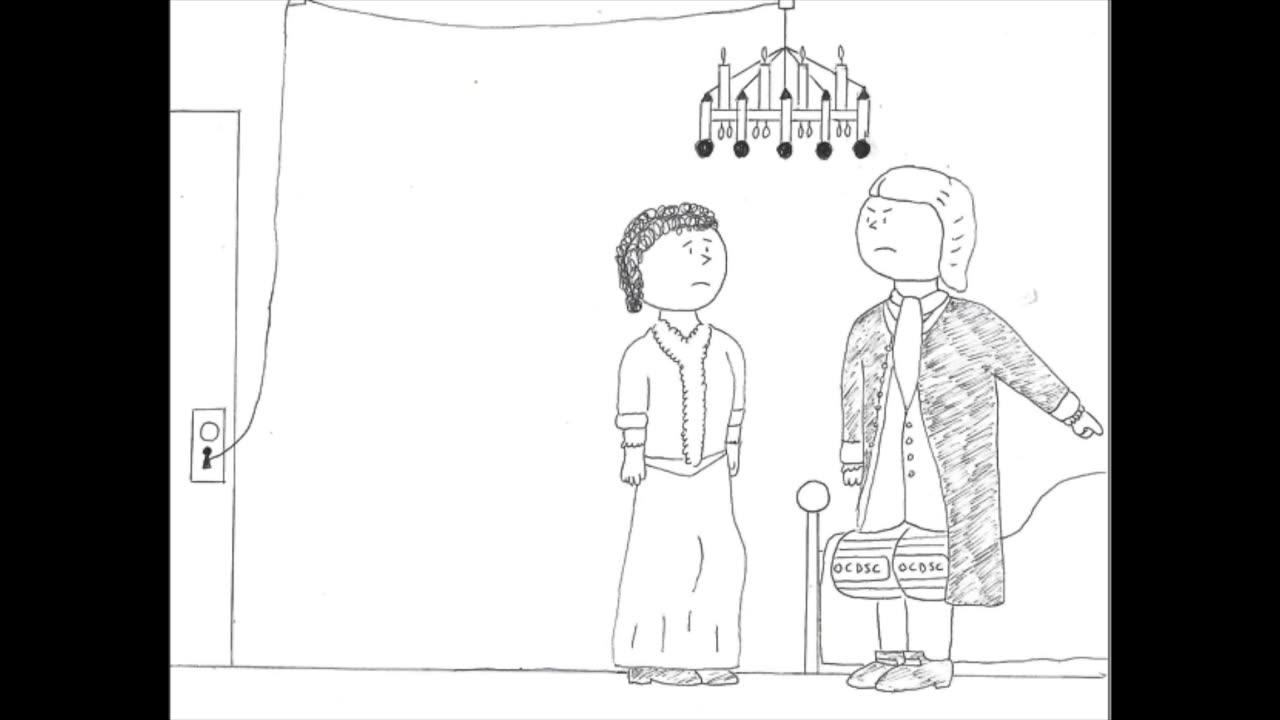Premium Only Content

Bundle of Workplace Comfort and Joy
This skit was inspired by the Henry Fielding novel “Tom Jones” (1749). This was the first time that we here at CoBaD have read a novel written by a justice of the peace, and based on its content, will probably be our last. Very long and meandering narration, the nemesis (Mr. Blifil) doesn’t have a first name, the widow Arabella Hunt only appears once in the whole book (Book 15, Chapter 11) and is mentioned in passing in Book 18, Chapter 10, and then only when it is convenient to the plot, too many “coincidences” (how could all those characters scattered all across England suddenly come across one another in London, a city which in 1750 had a population of 675,000?) and the very bizarre story told at the end of the novel by Mrs. Waters (introduced in the novel and this skit under the pseudonym Jenny Jones) concerning the identity of Tom’s parents (See Book 18, Chapters 7 and 8). Below is a paraphrase of the conversation between Jenny Jones/Mrs. Waters and Squire Allworthy at the end of the book, followed by CoBaD’s comments upon reading the text.
Jenny Jones/Mrs. Waters: Your sister Bridget was Tom’s mother. Summer was Tom’s dad. You remember Summer? He was a guest in your house who died of small pox (Note: Bridget and Mr. Allworthy lived in separate apartments on his estate).
Allworthy: I remember Summer, yes.
CoBaD: That’s funny, I don’t remember Mr. Summer at all. This is Book 18, Chapter 7. Why is this the first (and only) time he’s mentioned in the whole novel?
Jenny: Miss Bridget one day visited my mother just after your departure for London.
CoBaD: Who is Jenny’s mother? And again, why is this the first time she’s mentioned in the novel?
Jenny: Miss Bridget was pleased to say she had heard an extraordinary character of me, for my learning and superior understanding to all the young women.
CoBaD: So Bridget recruited Jenny, a woman of “extraordinary character” to participate in a massive cover up which would in turn destroy her character she worked so hard to build?
Jenny: Since you were away on business, this was an opportune time for Bridget to deliver the baby.
CoBaD: But on this particular trip, Allworthy was only away for three months. How could Allworthy not notice before he went on his trip that his sister was six months pregnant?
Jenny: I deposited the infant in your bed.
CoBaD: Why would Bridget have Jenny take her infant son, walk across to the other end of the estate and deposit him in her brother’s bed? And why would Bridget spend years living on the same estate with her own son living a lie (claiming that Tom was an abandoned child) and treating Tom with utter disdain?
Jenny: I was paid for my services.
CoBaD: There isn’t enough money in the world to make anyone here at CoBaD participate in this asinine plot. Remember, after depositing the baby, Jenny was mercilessly rebuked around Somersetshire for child abandonment, as people thought she was the mother. Here at CoBaD, Jenny still is the subject for scorn because she sold her good name.
Finally, there were so many characters parading in and out Mrs. Miller’s London home at the end of the book that Mrs. Miller could have been swimming in dough if she had replaced her front door with a turnstile. Apparently Mr. Fielding was in a hurry to tie up loose plot ends and finish the book. Perhaps we should have listened to Dr. Samuel Johnson when he said to Hannah Moore, “I am shocked to hear you quote from so vicious a book. I am sorry to hear you have read it…” Still, “The History of Tom Jones: A Foundling” was the inspiration for this silly sketch, so reading the book wasn’t a complete waste of time.
Deborah: "This keyhole may be monitored for quality and training purposes.” - In Book 1, Chapter 8, Bridget, Squire Allworthy’s sister, and Deborah Wilkins listened in on Mr. Allworthy’s sermon to Jenny Jones via a keyhole in Squire Allworthy’s study.
Allworthy: “I think you know why my 45 and 51 year old servant, Ms. Deborah Wilkins, brought you here...” - In Book 1, Chapter 3, Mrs. Deborah Wilkins, Squire Allworthy’s maid, is described as being “in her 52d year of her age,” (meaning she’s “51 and a bit” years old), but in Book 1, Chapter 5, Henry Fielding, in a baffling fashion, compares Mrs. Wilkins to a 45 year old dame: “Mrs. Deborah so sooner observed [the infant Tom Jones], than she fell to squeezing and kissing, with as great raptures as sometimes inspire the sage dame of forty and five towards a youthful and vigorous bridegroom, crying out in a shrill voice ‘O the dear little creature! The dear sweet, pretty creature! Well, I vow it is as fine a boy as I have ever seen!’”
Allworthy: “Pugh! My tried true tactics do nothing to you.” - “Pugh” is an interjection Sophia (Tom’s love interest) used in Book 6, Chapter 6. “Pugh” is used to indicate disgust.
Allworthy: “I-fackins, Jenny! Why didn’t you put it under the tree, then?” - Another one of our favorite interjections from the novel. “I-fackins” is an obsolete exclamation used to express surprise or insistence, similar to “I’faith” or “In faith” (nowadays it would be expressed as “Really!” or “Truly!”). For example, in Book 6, Chapter 6 of “Tom Jones,” when Mrs. Honour, the servant of Sophia (the love interest of Tom Jones), heard Sophia was going to be married against her will, Mrs. Honour said, “I don’t pretend to give your la’ship advice, whereof your la’ship knows much better than I can pretend to, being but a servant; but, i-fackins! no father in England should marry me against my consent.”
Jenny: “…But I must fall upon my knees and entreat you…Mr. Allworthy…” - A lot of characters fall upon their knees in this novel: Tom Jones, Sophia, Mr. Partridge, Jenny/Mrs. Waters and Mrs. Miller. We hope they had some decent gold plated knee pads to get them through the story.
Jenny: “…in the name of that jolly old two toned fat bastard and his eight courser dinner… Allworthy: Nine… Jenny: And his nine courser dinner…” – For more on this reference, see the “O Crispy Peas” sketch.
Jenny: “All I am permitted to say that he is of good character, a supporting kind, and not a throwaway name convenient to the plot of this novel.” - Like Arabella Hunt, Tom’s father, or Jenny’s mother; see note above. Jenny oughta know, she used to have a good character too, you know.
Allworthy: “Well, I can’t have her bending over a keyhole. That’d be conducting a highly repetitive task combined with high force and an awkward posture. NIOSH would never approve. Far better from an ergonomics standpoint to have to fall upon her knees, don’t you think?” – For more on who NIOSH (The National Institute for Occupational Safety and Health) is and what they do, or to be more precise, what they aren’t doing, see the “Hasty Worst” sketch.
Jenny: “…Now where do you want me to kneel while I fill this out?” Mrs. Wilkins: “On the hassock over there, next to the praying tarantulas.” - A reference to the brilliant “Two Ronnies” sketch “Mastermind.”
Bridget: “Make me look like your pious, crusty old battle-ax of an aunt, huh?!” –
In Book 1, Chapter 11, Henry Fielding writes the following:
“The Captain [Dr. Filial’s brother] no sooner perceived the passion of Miss Bridget, in which discovery he was very quick-sighted, than he faithfully returned it. The lady, no more than her lover, was remarkable for beauty. I would attempt to draw her picture; but that is done already by a more able master, Mr. Hogarth himself, to whom she sat many years ago, and hath been lately exhibited by that gentleman in his print of a Winter’s morning, of which she was no improper emblem, and may be seen walking (for walk she doth in the print) to Covent-Garden church, with a starved foot-boy behind carrying her prayer book.”
William Hogarth's “Morning (Four Times of The Day),” originally created as an oil painting in 1736, and reproduced as an engraving and published in 1738, does indeed depict a scene in Covent Garden on a wintry morning. There is a woman in the picture, but the picture is far from a flattering one. It is actually an ugly, elderly woman, lavishly dressed. She is on her way to church with a freezing page boy tagging behind carrying a prayer book. This “pious” elderly aristocrat purposely avoids looking at the beggar and the young lovers embracing each other. Allegedly William Hogarth modeled the ugly old lady after his aunt. When his aunt viewed the engraving, she cut him out of her will. This monumental gaffe of Fielding’s is particularly puzzling because Fielding and Hogarth actually knew each other.
Bridget: “Now I know why children have been giggling and pointing at me and people have been laughing at me behind my back for the past two years!” - As stated above, William Hogarth's “Morning (Four Times of The Day),” was originally created as an oil painting in 1736 and reproduced as an engraving and published in 1738, meaning that this ugly portrayal of Bridget had been floating around in one form or another for two years prior to the engraving “gift” Hogarth gave to Bridget.
Bridget: “I never should have got mixed up with a man who always speaks in uppercase letters!” - When he was a kid, a member of this troupe aspired to be a cartoonist. He “studied” a lot of cartoons. He couldn’t help but notice that almost all of them had their speech bubble dialogues IN CAPITAL LETTERS. Rarely was dialogue written in mixed case as you would see in books, newspaper articles and in this description. HE NOTED THAT ALL UPPER CASE DIALOGUE MADE CARTOON CHARACTERS LOOK LIKE THEY WERE EXTREMELY UNHAPPY INDIVIDUALS WHO SHOUTED AT EACH OTHER ALL THE TIME!!
Bridget: “FROM MY MIXED CASE TAPED UP LACE TO YOUR FACE, HAPPY BOXING DAY, SUCKA!” - The last drawing is a parody of the famous photograph taken by photographer Neil Leifer at the May 25, 1965 boxing match between Muhammed Ali and Sonny Liston (a rematch of their fight the previous year, which Ali also won). At the time the iconic Muhammed Ali/Sonny Liston photo was taken, Ali allegedly said to Liston, “Get up and fight, sucker!”
Bridget: “I SHOOK UP THE WORLD! I SHOOK UP THE WORLD! I AM THE QUEEN OF THE WORLD! I'M PRETTY! I’M A BAD GIRL!” - Based on a remark Ali said to a reporter after Ali’s first victory over Sonny Liston on February 25, 1964 in Miami Beach, Florida. (“I shook up the world!...I shook up the world!...I am the king of the world! I’m pretty! I’m a bad man!”)
For more on Overengineered Safety Corporation, the makers of fine products such as Lon the Bowler’s Ass a Backed up System, please see the “Hasty Worst” sketch.
References:
Artoftheprint.com. William Hogarth - Morning Four Times of The Day. www.artoftheprint.com/artistpages/hogarth_william_morningnooneveningnightcompletesetoffour.htm
Bednall, J. (2015, May 25). The story behind the greatest photograph in sports history. News.com.au. https://www.news.com.au/sport/sports-life/the-story-behind-the-greatest-photograph-in-sports-history/news-story/781e32670a84a2bfadcfb494eb0a924d
Fielding, H. (1985). The History of Tom Jones, A Foundling. (R.P.C. Mutter, Ed.). Penguin Classics. (Original work published 1749)
-
 24:24
24:24
InspirePlay
10 days ago $1.42 earnedInsane 6 Person Knockout challenge
9.03K1 -
 50:34
50:34
Ben Shapiro
2 hours agoEp. 2088 - Joe and Mika BEND THE KNEE
29.8K24 -
 1:12:42
1:12:42
The New American
2 hours agoShould The U.S. Military Be Involved in Mass Deportations? | The New American Daily
5.9K10 -
 19:17
19:17
Brewzle
3 hours agoI Bought A Whiskey Distillery!
2.76K -
 LIVE
LIVE
The Big Mig™
2 hours agoTRAFFICKED, EXPLOITED, & MISSING: MIGRANT CHILDREN VICTIMS OF THE BIDEN-HARRIS ADMINISTRATION
229 watching -
 1:00:59
1:00:59
Russell Brand
4 hours agoMorning Joe Hosts Meet with Hitler...Sorry, Trump, Kamala Paid Oprah $2.5M & RFK vs Vaccines – SF496
104K206 -
 1:01:15
1:01:15
The Dan Bongino Show
6 hours agoTrump Is “Flooding The Zone” (Ep. 2373) - 11/19/2024
723K2.67K -
 1:02:41
1:02:41
The Rubin Report
4 hours agoMSNBC Hosts Shock Audience by Disclosing Details of Their Secret Trump Meeting
90.5K102 -
 2:09:44
2:09:44
Steven Crowder
6 hours agoWhy Trump's FCC PICK Terrifies the Deep State & Bathroom Trouble for Trans Rep Sarah McBride
423K272 -
 1:01:32
1:01:32
TheAlecLaceShow
4 hours agoGuest: Roger Stone | Biden Pushes WW3 | Trump Cabinet Picks | Libs Blame Racism | The Alec Lace Show
18.8K9